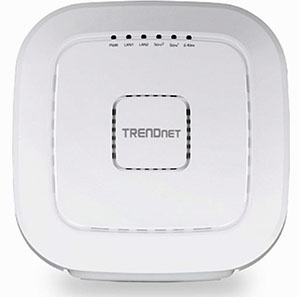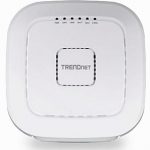TRENDnet TEW-826DAP Tri-Band PoE+ Indoor Wireless Access Point
TRENDnet is a house hold name in the networking community and requires no special introduction. Founded in California, this company has successfully been able to become a household name for core networking products and periphery devices. Today we look at one of their newest additions to their extensive lineup of products; the TRENDnet TEW-826DAP wireless access point.
Product Link: https://www.trendnet.com/products/product-detail?prod=110_TEW-826DAP
Access points allow you to extend your wireless network significantly and depending on the type of devices you use, it allows you to customize the environment exactly as you want. With the features offered on the TEW-826DAP you get to do exactly that so read on as we explore its capabilities.
Specifications
| Standards | IEEE 802.3, 802.3u, 802.3x, 802.3ab, 802.3at, 802.1Q, 802.11a, 802.11b, 802.11g, 802.11n (up to 400Mbps @ 256QAM), 802.11ac Wave 2 (5GHz1: up to 867Mbps, 5GHz2: up to 867Mbps @ 256QAM) |
| Hardware Interface | 1 x PoE+ Gigabit LAN port (power input) 1 x Gigabit LAN port Power port (optional non-PoE installation) LED indicators Mounting plate and cable guard On/Off power button Reset button |
| Features | 802.11ac MU-MIMO Wave 2 support IP30 rated housing (with mounting plate and cable guard installed) Concurrent Tri-Band Band steering WiFi traffic shaping 802.1Q VLAN assignment per SSID IPv6 support (Link-Local, Static IPv6, Auto-Configuration (SLAAC/DHCPv6)) Multi-Language interface, English, French, Spanish, German, Russian LEDs on/off External Captive Portal (Coovachilli server authentication) Internal Captive Portal (Local user account authentication and customizable portal page) 802.11k intelligent radio resource management RSSI Threshold (client signal strength and connectivity control) Airtime Fairness |
| Operation Modes | Access Point Client Bridge WDS AP WDS Bridge WDS Station Repeater |
| Management/Monitoring | Web based management AP software utility SNMP v1/v3STP Event logging Ping test Traceroute Telnet |
| Access Control | Wireless encryption: WEP, WPA/WPA2-PSK, WPA/WPA2-RADIUS MAC filter Maximum client limit |
| QoS | WMM Bandwidth control per SSID or client |
| SSID | Up to 8 SSIDs per wireless band (24 total) |
| Frequency | 2.4GHz: 2.412 – 2.472GHz 5GHz1: 5.180 – 5.320GHz 5GHz2: 5.500 – 5.825GHz |
| Wireless Channels | 2.4GHz: FCC: 1–11, ETSI: 1 – 13 5GHz: FCC: 36, 40, 44, 48, 149, 153, 157, 161 and 165 ETSI: 36, 40, 44, 48 (52, 56, 60, 64, 100,104,108,112,116, 132,136,140)** |
| Modulation | DBPSK/DQPSK/CCK for DSSS technique BPSK/QPSK/16-QAM/64-QAM/256-QAM for OFDM technique |
| Antenna Gain | 2.4GHz: 2 x 4 dBi internal 5GHz1: 2 x 4 dBi internal 5Ghz2: 2 x 4 dBi internal |
| Wireless Output Power | 802.11a: FCC: 27.76 dBm (max.) / CE: 28.4 dBm (max.) / IC: 30.18 dBm (max.) 802.11b: FCC: 29.22 dBm (max.) / CE: 17.82 dBm (max.) / IC: 30.79 dBm (max.) 802.11g: FCC: 28.2 dBm (max.) / CE: 18.71 dBm (max.) / IC: 30.23 dBm (max.) 802.11n (2.4GHz): FCC: 28.56 dBm (max.) / CE: 18.79 dBm (max.) / IC: 30.41 dBm (max.) 802.11n (5GHz): FCC: 28.74 dBm (max.) / CE: 28.74 dBm (max.) / IC: 30.37 dBm (max.) 802.11ac: FCC: 27.45 dBm (max.) / CE: 28.74 dBm (max.) / IC: 29.55 dBm (max.) |
| Receiving Sensitivity | 802.11a: -70 dBm (typical) @ 54 Mbps 802.11b: -85 dBm (typical) @ 11 Mbps 802.11g: -72 dBm (typical) @ 54 Mbps 802.11n (2.4 GHz): -67 dBm (typical) @ 400 Mbps 802.11n (5 GHz): -67 dBm (typical) @ 400 Mbps 802.11ac: -64 dBm (typical) @ 867 Mbps |
| Power | IEEE 802.3at Type 2 PoE PD Class 4 Input: 100 – 240V AC, 50/60Hz, Output: 12V DC, 2A external power adapter (optional) Max. consumption: 18.96W |
| Operating Temperature | 0° – 40° C (32° – 104° F) |
| Operating Humidity | Max. 95% non-condensing |
| Certifications | CEFCCIC |
| Dimensions | 214 x 214 x 36mm (8.4 x 8.4 x 1.4 in.) |
| Weight | 684g (1.51 lbs.) |
| Warranty: | 3 year |
| Table of contents |
| 1. Introduction |
| 2. Design and Features |
| 3. Conclusion |

